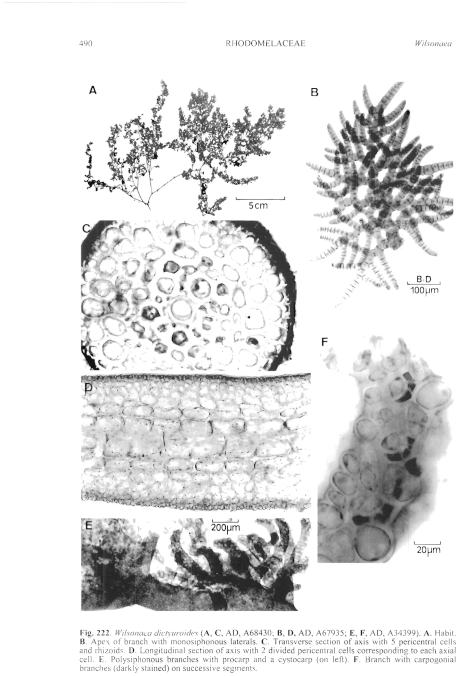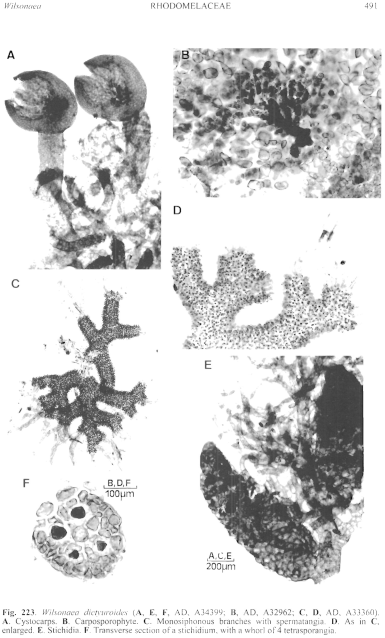|
|
|
|
|
|||||||||||
|
Electronic Flora of South Australia Species Fact Sheet
Phylum Rhodophyta – Family Rhodomelaceae – Tribe Uncertain
Selected citations: De Toni 1903: 1146. Falkenberg 1901: 527, pl. 12 figs 22, 23. Kylin 1956: 555. Lucas 1909: 47. Lucas & Perrin 1947: 306. May 1965: 379. Schmitz & Falkenberg 1897: 451. Shepherd & Womersley 1981: 367.
Synonym
Dasya dictyuroides J. Agardh 1890: 111, pl. 3 fig. 5. Parsons & Womersley 1998: 479.
Thallus (Fig. 222A) medium to dark red-brown, 4–25 cm high, much branched irregularly radially, with a robust main axis 2–3 mm in diameter and laterals 0.5–1.5 mm in diameter, denuded below the apical tufts of monosiphonous laterals at the ends of lesser branches. Holdfast discoid-conical, 2–10 mm across; epilithic. Structure. Apices monopodial (Fig. 222B), apical cells dome-shaped, 14–20 µm in diameter with thin walls, monosiphonous and unbranched for 8–12 cells and below this cutting off exogenous lateral monosiphonous branches from each of 4–6 cells, with segments below this cutting off 4 (–5) pericentral cells (Fig. 222C) bearing monosiphonous lateral filaments which become basally polysiphonous; pericentral cells dividing transversely (Fig. 222D) into 2 irregular tiers and thus with 2 tiers between the monosiphonous lateral branches, and later becoming separated by rhizoidal cells and with a cortex becoming many cells thick below; the rhodoplastic monosiphonous laterals become branched at each cell in their lower parts (Fig. 222B), with adhering bases at the dichotomies, and the lower segments become polysiphonous; lower monosiphonous cells 50–75 µm in diameter and L/D (1–) 1.5–2.5, upper simple branches 5–12 cells long, tapering to terminal cells 20–30 µm in diameter and L/D (2–) 5–8, apices rounded. Cells uninucleate, larger ones multinucleate; rhodoplasts discoid, chained in larger cells.
Reproduction: Gametophytes dioecious. Procarps on special polysiphonous branches (Fig. 222E) below terminal tufts, on several successive segments (Fig. 222F), with a 4-celled carpogonial branch. Carposporophytes (Fig. 223B) with a basal branched fusion cell and branched gonimoblast with shortly clavate terminal carposporangia 30–45 µm in diameter; vegetative cells adjacent to the gonimoblast base becoming darkly staining. Cystocarps (Fig. 223A) lateral and terminal on short branches, more-or-less ovoid, 0.3–1 (–1.5) mm in diameter; pericarp ostiolate, with about 10 longitudinal filaments, corticated and 5–8 cells thick, outer cells isodiametric, irregularly placed. Spermatangia (Fig. 223C, D) cover lower monosiphonous cells of the laterals, with short pericentral cells branching and lying along the parent cell and producing an outer cortical layer then with outermost spermatangial initials.
Stichidia (Fig. 223E) robust, borne near base of lesser branches, lanceoid to elongate, 250–450 1 µm in diameter and 1–1.5 mm long, with whorls of 4–5 pericentral cells and 3–4 tetrasporangia (Fig. 223F) 70–120 µm in diameter, 3 cover cells and an outer layer of cortical cells.
Type from Western Port, Vic. (Wilson 66, 7.i.1885); holotype in Herb. Agardh, LD, 44358 (this is the only specimen in Herb. Agardh collected before 1890).
Selected specimens: Hopetoun, W. Aust., drift (Parsons, 20.xi.1968; AD, A33360-"Marine Algae of southern Australia" No. 118) and 3–4 m deep on rocks under jetty (Kraft & Ricker, 16.viii.1979; MELU, K6999). Eyre, W. Aust., drift (Parsons, 22.xi.1968; AD, A34399). Marion Bay, S. Aust., drift (Womersley, 9.x.1998; AD, A67935). Off Troubridge I., S. Aust., 23 m deep (Shepherd, 4.ii.1969; AD, A33830). Port Elliot, S. Aust., drift (Gordon, 8.x.1967; AD, A32961). Seal Bay, Kangaroo I., S. Aust., drift (Womersley, 22.xi.1968; AD, A32962). Bales Beach, Kangaroo I., S. Aust., drift (Womersley, 29.xii.1999; AD, A68430). Port Phillip Heads, Vic. (Wilson, 9.ii.1894; MEL, 584174).
Distribution: Hopetoun, W. Aust., to Western Port, Victoria.
Taxonomic notes: Parsons & Womersley (1998, p. 479) commented briefly on Wilsonaea dictyuroides, considering that detailed studies were needed of its relationships.
References:
AGARDH, J.G. (1890). Till algernes systematik. Acta Univ. lund. 26(3), 1–125, Plates 1–3.
DE TONI, G.B. (1903). Sylloge Algarum omnium hucusque Cognitarum. Vol. 4. Florideae. Sect. 3. pp. 775–1521 + 1523–1525. (Padua.)
FALKENBERG, P. (1901). Die Rhodomelaceen des Golfes von Neapel und der angrenzenden Meeres-abschnitte. Fauna und Flora des Golfes von Neapel. Monogr. 26. (Friedländer: Berlin.)
KYLIN, H. (1956). Die Gattungen der Rhodophyceen. (Gleerups: Lund.)
LUCAS, A.H.S. & PERRIN, F. (1947). The Seaweeds of South Australia. Part 2. The Red Seaweeds. (Govt Printer: Adelaide.)
LUCAS, A.H.S. (1909). Revised list of the Fucoideae and Florideae of Australia. Proc. Linn. Soc. N.S.W. 34, 9–60.
MAY, V. (1965). A census and key to the species of Rhodophyceae (red algae) recorded from Australia. Contr. N.S. W. Natl Herb. 3, 349–429.
PARSONS, M.J. & WOMERSLEY, H.B.S. (1998). Family Dasyaceae Kützing 1843: 413, 414 in Womersley H.B.S. The Marine Benthic Flora of southern Australia. Part IIIC. State Herbarium of South Australia, 422–510.
SCHMITZ, F. & FALKENBERG, P. (1897). Rhodomelaceae. In Engler, A. & Prantl, K., Die natürlichen Pflanzenfamilien. T.1. Abt. 2, pp. 421–480. (Englemann: Leipzig.)
SCHMITZ, F. (1893). Die gattung Lophothalia, J. Ag. Ber. Deutsch. Bot. Ges. 11, 212–232.
SHEPHERD, S.A. & WOMERSLEY, H.B.S. (1981). The algal and seagrass ecology of Waterloo Bay, South Australia. Aquat. Bot. 11, 305–371.
The Marine Benthic Flora of Southern Australia Part IIID complete list of references.
Publication:
Womersley, H.B.S. (24 February, 2003)
The Marine Benthic Flora of Southern Australia
Rhodophyta. Part IIID. Ceramiales – Delesseriaceae, Sarcomeniaceae, Rhodomelaceae
Reproduced with permission from The Marine Benthic Flora of Southern Australia Part IIID 2003, by H.B.S. Womersley. Australian Biological Resources Study, Canberra. Copyright Commonwealth of Australia.
Illustrations in Womersley Part IIIA, 2003: FIGS 222, 223.

Figure 222 enlarge
Fig. 222. Wilsonaea dictyuroides (A, C, AD, A68430; B, D, AD, A67935; E, F, AD, A34399). A. Habit. B. Apex of branch with monosiphonous laterals. C. Transverse section of axis with 5 pericentral cells and rhizoids. D. Longitudinal section of axis with 2 divided pericentral cells corresponding to each axial cell. E. Polysiphonous branches with procarp and a cystocarp (on left). F. Branch with carpogonial branches (darkly stained) on successive segments.

Figure 223 enlarge
Fig. 223. Wilsonaea dictyuroides (A, E, F, AD, A34399; B, AD, A32962; C, D, AD, A33360). A. Cystocarps. B. Carposporophyte. C. Monosiphonous branches with spermatangia. D. As in C, enlarged. E. Stichidia. F. Transverse section of a stichidium, with a whorl of 4 tetrasporangia.

|
Email Contact: State Herbarium of South Australia |

|